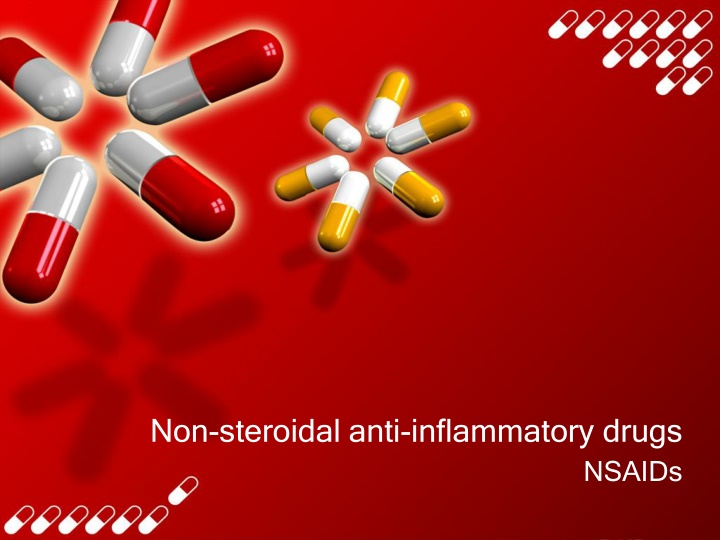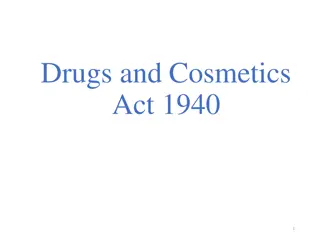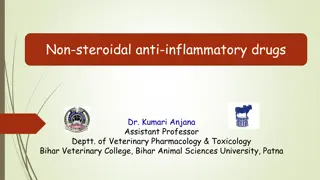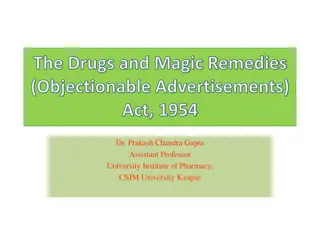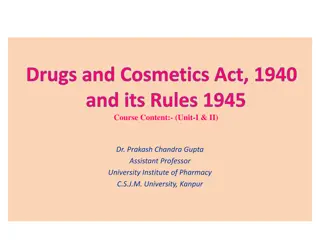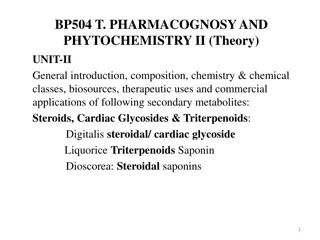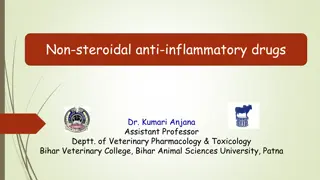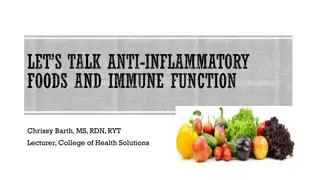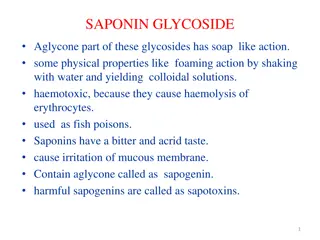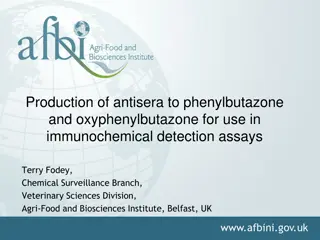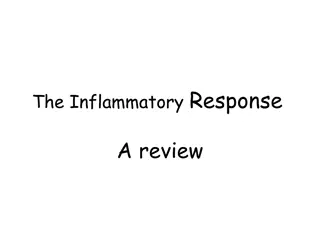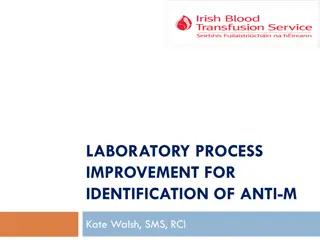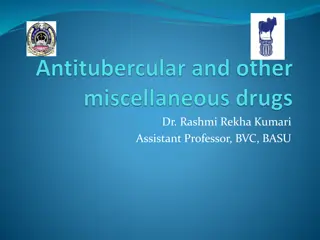Non-steroidal anti-inflammatory drugs
the classification, mechanism of action, and examples of Non-Steroidal Anti-Inflammatory Drugs (NSAIDs) along with their pharmacological actions, therapeutic uses, adverse effects, and contraindications. Learn about selective vs. non-selective NSAIDs, COX inhibitors, and the difference between various NSAID types.
Download Presentation

Please find below an Image/Link to download the presentation.
The content on the website is provided AS IS for your information and personal use only. It may not be sold, licensed, or shared on other websites without obtaining consent from the author.If you encounter any issues during the download, it is possible that the publisher has removed the file from their server.
You are allowed to download the files provided on this website for personal or commercial use, subject to the condition that they are used lawfully. All files are the property of their respective owners.
The content on the website is provided AS IS for your information and personal use only. It may not be sold, licensed, or shared on other websites without obtaining consent from the author.
E N D
Presentation Transcript
OBJECTIVES OBJECTIVES At the end of this work you should : Define NSAIDs NSAIDs Describe the classification of this group of drugs Describe the general mechanism of actions Define the following terms : Analgesic Antipyretics Anti-inflammatory Anti-platelet Describe the general pharmacological actions Describe the general therapeutic uses Describe the general adverse effects Describe the general contraindications Know some examples of each group of NSAIDs Know the difference between the selective & non-selective NSAIDs
NSAIDs & Terms Non-steroidal anti-inflammatory drugs ( NSAIDs ): are group of drugs that have analgesic , antipyretic , anti-platelet & anti- inflammatory effects. ANALGESIC: Drug that relieve pain. ANTIPYRETIC Drug that lower the elevated body temperature to normal. Anti-inflammatory Refers to the property of a substance or treatment that reduces inflammation or swelling. Anti-platelet Is a member of a class of pharmaceuticals that decrease platelet aggregation and inhibit thrombus formation.
Classification of NSAIDs Selective COX2 Selective COX2 Inhibitor. Inhibitor. Non Non- -Selective COXs Selective COXs Inhibitor: Inhibitor: Group of drugs that sharing the capacity to induce the following pharmacological actions: Analgesic Antipyretic Anti-inflammatory Anti-platelet Effect on the kidney function
MECHANISM OF ACTION OF NSAIDS Phospholipid From Cell Membrane Phospholipase Arachidonic acid CycloOxygenase 1 CycloOxygenase 2 Prostaglandin Prostacyclin Prostaglandin Thromboxane Phospholipase CycloOxygenase 1 can be inhibit by NSAIDs. CycloOxygenase 2 can be inhibit by NSAIDs and COX-2 inhibitor. can be inhibit by Corticosteroid.
COX inhibitors NSAIDs NSAIDs NonSelective (NS) COX-1/COX-2 COX-2 inhibitors COX-3 inhibitors Selective (Coxibs) Preferential (Meloxicam) Paracetamol Diclofenac Reversible inhibition of both COX-1 & COX-2 enzymes EXCEPT Aspirin is the only NS-NSAID that Irreversible inhibitor of both enzymes Resulting in inhibition of the synthesis of prostaglandins & thromboxane A2.
Pharmacokinetics Oral administration Most NSAIDs are weak acid (absorbed well in stomach stomach and intestinal mucosa intestinal mucosa) Most metabolized in liver liver (oxidation & conjugation) 95% bound to plasma-protein (high high bioavailability bioavailability)
Pharmacodynamics Effects 1-ANALGESIC Bradykinin Histamine Factors Nerve ending of pain Prostaglandin PgE2 , PgF2 2-Antiinflammatory Bradykinin Histamine 5-HT Factors Nerve ending of pain Prostaglandin PgE2 , PgF2 NSAIDs will block Prostaglandin production. It happen in Peripheral tissue.
Pharmacodynamics Effects 3-ANTIPYRETIC Pyrogen Prostaglandins PGE2 NSAIDs will block Prostaglandin production. It happen in Central nervous system. Thermoregulatory center Increase set point Increase heat production and Decrease heat dissipation Fever
THERAPEUTIC USES SHARED BY NS-NSAIDs Antipyretic. Analgesic: Headache, Migraine. Dental pain. Dysmenorrhea. Common cold. Anti-inflammatory & Antirheumatic: Rheumatoid arthritis / myositis or other forms of inflammatory conditions.
Adverse effects shared by NS-NSAIDs GIT upsets ( nausea, vomiting). GIT bleeding & ulceration. Bleeding. Allergic reaction. Inhibition of uterine contraction. Salt & water retention. EFFECTONTHEKIDNEY Inhibitionof both COX-1& COX-2 enzymes (mainly COX-2), inhibit synthesis of PGE2 & PGI2 that are responsible for maintaining renal blood flow. Salt & water retention & edema of lower limbs. Hyperkalemia. Interstitial nephritis.
Aspirin Clinical uses of Aspirin : Acute rheumatic fever Acute rheumatic fever (Antioxidant effect) . Low doses used as cardio protective incidence of myocardial infarction & unstable angina. Large doses (5gm) used to treat chronic gouty arthritis Chronic use of small doses of aspirin used as protective to reduce the incidence of colorectal cancer colorectal cancer (Antioxidant effect). Adverse Effects Related to: Therapeutic Doses Of Aspirin: Aspirin asthma. Acute Gouty arthritis. Reye's syndrome. Chronic use: Salicylism (ringing of ear(tinnitus),vertigo). OVER DOSE Hyperthermia Metabolic acidosis Respiratory depression Coma cardio protective to reduce the chronic gouty arthritis.
Aspirin Contraindications: Peptic ulcer. Pregnancy. Hemophilic patients. Patients taking anticoagulants. Children with viral infections. Gout (small doses).
Paracetamol Is commonly used as analgesic antipyretic antipyretic. . Conditions in which paracetamol is a suitable drug: Peptic or gastric ulcers. Bleeding tendency. Allergy to aspirin. Viral infections especially in children . During Pregnancy. Adverse Effects (due to its active metabolite): Therapeutic doses: Increase liver enzymes Increase liver enzymes. Large doses : causes kidney failure kidney failure. Over dose: Acute toxicity Acute toxicity: liver failure ( cause of death) Treatment Of acute toxicity acute toxicity by : N-acetylcysteine ( SH-donor) to neutralize the toxic metabolite analgesic And
DICLOFENAC (accumulate in synovial fluid) Clinical uses Clinical uses Preparations Preparations Rheumatoid arthritis , osteoarthritis & ankylosing spondylitis. Acute gouty arthritis Analgesic Antipyretic Locally to prevent post- opthalmic inflammation Oral. Oral with misoprostol to decrease upper gastrointestinal ulceration. 0.1% opthalmic ( eye drops) to decrease postoperative opthalmic inflammation. A topical gel 3% . Rectal suppository. Oral mouth wash. Intramuscular preparations.
Selective COX-2 inhibitors General adverse General adverse effects effects GENERAL GENERAL CLINICAL USES CLINICAL USES General advantages General advantages CONTRAINDICATIONS CONTRAINDICATIONS Potent anti- inflammatory. Antipyretic & analgesic. Lower incidence of gastric upset (recommneded in patients with a history of gastric ulceration). No effect on platelet aggregation. Renal toxicity. Dyspepsia & heartburn. Allergy. Increase incidence of myocardial infarction. Commonly used as antinflammatory drugs Rheumatoid arthritis Osteoarthritis Acute gouty arthritis Acute musculoskeleta l pain Ankylosing spondylitis Dysmenorrhea In a patient with a history of : Renal impairment Myocardial infarction ( lack cardioprotective effect of NSAIDs as they have no effect on COX-1 enzyme) NS- ( Have no inhibitory effect on (COX-1) so can be given in hemophilic patients).
Example: Celecoxib o Example: Celecoxib Half-life 11 hours (twice/day). Food decrease its absorption. Highly bound to plasma proteins. Clinical uses & Adverse effects: Discussed before with general uses and general adverse effects of selective COX-2 inhibitors.
Summary NSAIDs are group of drugs that have analgesic, antipyretic, anti- platelet & anti-inflammatory effects. They are classified according to their action on COX-enzymes into non- selective that inhibit both COX-1 & COX-2 & selective that inhibit only COX-2 enzymes. They are sharing in common therapeutic uses as analgesic to relief mild to moderate pain not visceral pain , reducing high body temperature, preventing clot formation , so aspirin can be used as prophylaxis in ischemic heart disease. As anti-inflammatory in rheumatic , rheumatoid arthritis, desmenrrhea and other inflammatory conditions including muscles or bones. The common adverse effects includes : gastric upset ( nausea, vomiting ,gastric ulceration or bleeding). Allergy. Edema. They are contraindicated mainly in patients with peptic ulcer , bleeding tendency or in pregnancy . Selective COX-2 inhibitors as celecoxib are potent anti-inflammatory & analgesic ,but have no anti-platelet effect & less gastric upset. They can be used in patients with gastric ulcer , haemophilia . Their common adverse is mainly on kidney & cardiovascular system.
THANK YOU Done By: Fahad Alfahad Mohammed Almozini Quiz Quiz pharmacology434@gmail.com pharmacology434@gmail.com
